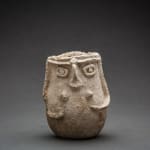Anthopomorphic Jar With Facial Features in Relief, 2500 BCE - 2000 BCE
Burnished Clay
height 10.2 cm
height 4 in
height 4 in
LO.1039
Further images
Vessel with piriform body, high neck with slightly everted rim and flat base. The protrusions on the body denoting breasts, while the two arms in relief are bent on the...
Vessel with piriform body, high neck with slightly everted rim and flat base. The protrusions on the body denoting breasts, while the two arms in relief are bent on the belly. Eyes and mouth are applied in relief below two horizontal continuous lines indicating eyebrows. A sharp flattened curved protuberance indicates the nose while the ears are flanges continuing into the arms.
This type of antropomorphic vessel would have had either a discoid or curved lid with a small horn-shaped projection on the top.
This vase is a typical example of the anthropomorphic pottery from Troy, datable to the Early Bronze Age II-III (Troy II-V). Pottery with mould, incised or painted rendering of human features or full figures -for the most part female- constituted a special category of Early Bronze Age pottery thoughout the Aegean and western Anatolian world, with a particular significance, probably symbolic and a special use, possibly ritual.
For a comparable example see: J. Aruz ed., The Art of the First Cities, 2003: p. 274, no. 179.
This type of antropomorphic vessel would have had either a discoid or curved lid with a small horn-shaped projection on the top.
This vase is a typical example of the anthropomorphic pottery from Troy, datable to the Early Bronze Age II-III (Troy II-V). Pottery with mould, incised or painted rendering of human features or full figures -for the most part female- constituted a special category of Early Bronze Age pottery thoughout the Aegean and western Anatolian world, with a particular significance, probably symbolic and a special use, possibly ritual.
For a comparable example see: J. Aruz ed., The Art of the First Cities, 2003: p. 274, no. 179.







